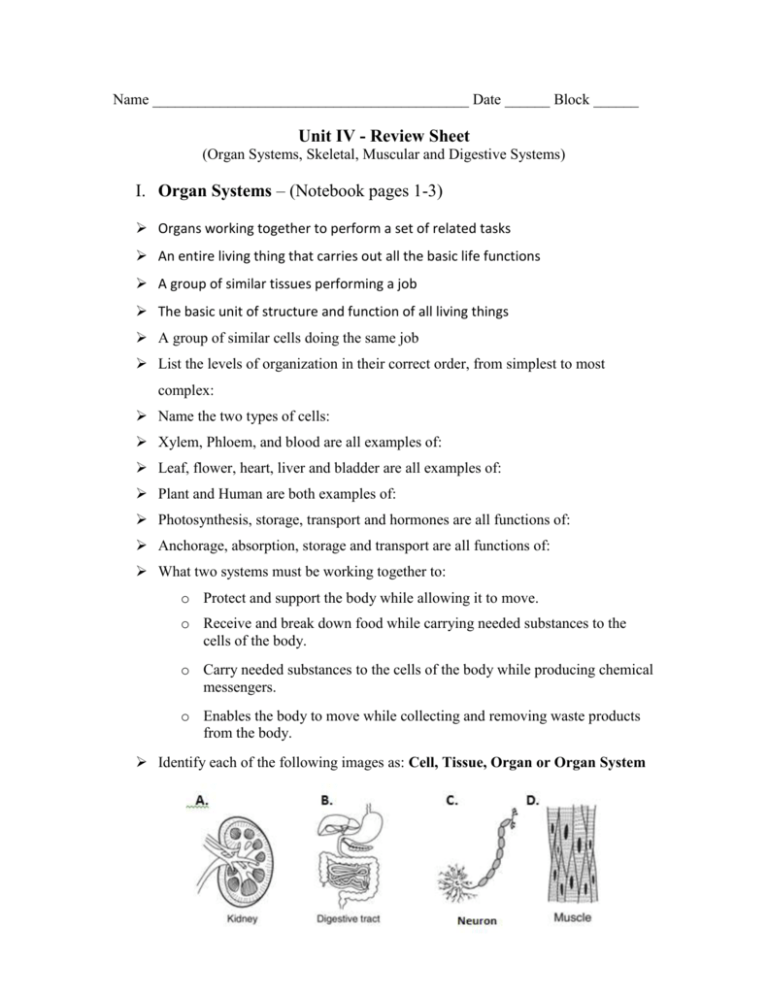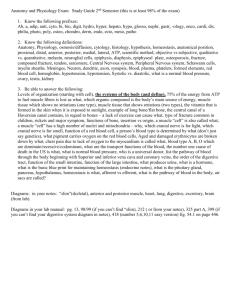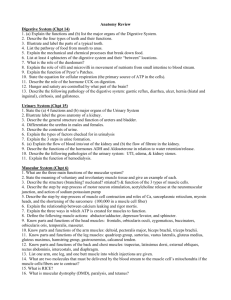Unit IV Review Sheet
advertisement

Name __________________________________________ Date ______ Block ______ Unit IV - Review Sheet (Organ Systems, Skeletal, Muscular and Digestive Systems) I. Organ Systems – (Notebook pages 1-3) Organs working together to perform a set of related tasks An entire living thing that carries out all the basic life functions A group of similar tissues performing a job The basic unit of structure and function of all living things A group of similar cells doing the same job List the levels of organization in their correct order, from simplest to most complex: Name the two types of cells: Xylem, Phloem, and blood are all examples of: Leaf, flower, heart, liver and bladder are all examples of: Plant and Human are both examples of: Photosynthesis, storage, transport and hormones are all functions of: Anchorage, absorption, storage and transport are all functions of: What two systems must be working together to: o Protect and support the body while allowing it to move. o Receive and break down food while carrying needed substances to the cells of the body. o Carry needed substances to the cells of the body while producing chemical messengers. o Enables the body to move while collecting and removing waste products from the body. Identify each of the following images as: Cell, Tissue, Organ or Organ System Which diagram above represents an organ system of a plant? Which diagram above represents a cell in a plant? Which diagram above represents an organism? Which diagram above represents an organ in the plant? II. Skeletal System – ( Notebook pages 4-8 & 13) What are the 5 functions of the skeletal system? o o o o o Skeleton is Greek for “ __________________________________________” What are the 4 different classifications of bone: o - radius, ulna, humerus & femur o - cranium, pelvic girdle o - fingers & toes (phalanges) o - vertebrae What type of tissue are both blood and bone classified as? What are the two types of marrow and what does each produce? o o - The average adult human skeleton has how many bones? The job of this tissue is to cushion the bones from sudden jolts, provide a slippery surface between the bones and repair broken areas: Define: o Ossified – o Joint – o Ligament – o Tendon – This type of joint allows for no movement at all: This type of joint allows for the greatest range of movement: This type of joint allows only back and forth movement: This type of joint allows one bone to rotate around another: Name each of the following types of joints: (Shoulder) ______________________ (Elbow) ___________________ Label the diagram of the skeleton: (21 labels) (Vertebrae) _______________________ III. Muscular System – (Notebook pages 9-14) Banded or striped The change in a muscle by which it becomes thicker and shorter The more than 600 muscles that work together to move the body Muscle tissue that is under our conscious control Muscle tissue that is not under our conscious control - Identify the three types of muscles and where in the body it’s found? Type __________________________________ Where is it found? _______________________ ______________________________________ Type __________________________________ Where is it found? _______________________ ______________________________________ Type __________________________________ Where is it found? _______________________ ______________________________________ Cardiac muscle has characteristics in common with both ____________________ and ______________________. o Exactly what characteristic does it share with each of the two muscle types? Muscles are only able to _______________ and therefore they must always work in ______________________. During a muscular contraction the muscle becomes ________________ in length and __________________ in size. Skeletal muscle is also called “ ________________________” muscle. Running, throwing and jumping are all examples of what type of action? Define: o Voluntary muscle – o Involuntary muscle– Determine what kind of muscle (voluntary or involuntary) each of the following are: o Skeletal Muscles – o Cardiac Muscles – o Smooth Muscles – This holds bone to bone: This holds muscle to bone: Use the diagram below to answer the questions that follow: In the bending diagram: o what action is the biceps muscle doing? What does this cause the muscle to look like? o What action is the triceps muscle doing? What does this cause the muscle to look like? o What type of muscle is shown at A? o What type of joint is B? In the straightening out diagram: o What type of connective tissue is C? o What action is the biceps muscle doing? o What action is the triceps doing? IV. Digestive System – (notebook pages 15-18) What are the three functions of the digestive system? o o o Proteins that speed up chemical reactions. A small flap of skin that stops food from entering the respiratory system as you swallow. The physical breaking apart of food particles into smaller particles. One-directional muscular contractions of the esophagus The digestion of food particles by enzymes. A mass of chewed food: A liquid mass of food: The chewing and grinding of food: A solid waste product: In what part of the digestive system does most chemical digestion occur? In what part of the digestive system does most mechanical digestion occur? What 3 organs are considered “digestive helpers” and what do they do/produce? o o o What is the largest and heaviest internal organ of the body? This is Greek for “to carry what is eaten”: The absorption of water mainly takes place here: Label the diagram of the Digestive System (7 labels) Fill in the table with the correct information. Type of Digestion Structure Teeth Saliva Esophagus stomach Small intestine Large intestine Rectum Anus (Mechanical, Chemical, Both, None)









